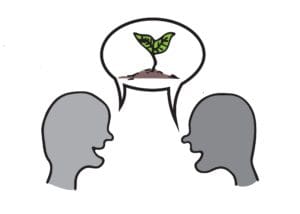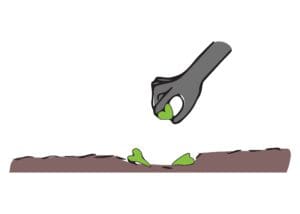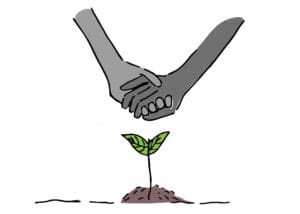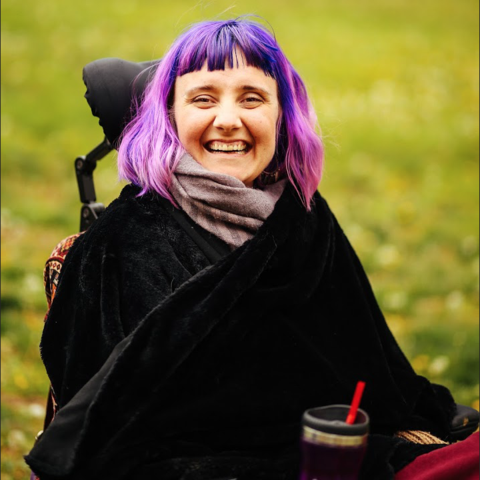创建无异议和无成见的课堂
 学
学
The largest minority group in the U.S. is people with disabilities. Educate yourself on the ableist structures and common stigmas found within educational environments.
 尝试
尝试
If a student works with a 1:1 Paraprofessional and you’re giving an instruction to the student, make eye contact and directly speak to the student first, not assisting companions.
 尝试
尝试
Ask students with speech or hearing impairments for the modes of communication they are most comfortable with before beginning your lesson.
![]() 记住
记住
Be intentional about introductions. How you introduce yourself and how you create opportunities for others to creatively introduce themselves and self-identify can set the tone for your time with students.
提示:
Just like identities, disabilities aren’t always easily noticeable. Have an awareness, respect, and sensitivity to what may not be seen.
The Impact of Ableism and Stigma Matter
Understanding ableism and stigma and its impact on individuals and classrooms empowers you to be a compassionate educator who preserves and protects the dignity and lived experience of students with disabilities. This awareness can also support you in advocating for the rights of disabled students in the school and beyond.
Ableism…
- isolates individuals;
- segregates learners;
- infects policymaking;
- emerges as structural and social discrimination.
Be Mindful of Your Language

Image credit: Jean Wong
Words have power. The language you use can have an affect on an individual’s perception of themselves or others.
Language is verbal and nonverbal. Body language and paralanguage often communicate more than what we are expressing with words.
The tone in your voice is equally important to the listener as the tone in your writing is to your reader. Your tone expresses your attitude and respect for the students observing you. Be mindful of your delivery.
了解更多 GIVE Inclusive Language Guide.
Be Conscious of Any Verbal Innuendo
“As you talk about someone with a mental illness, you may pair certain words with a change in your tone of voice. For example, you may whisper the terms depression or bipolar. People pick up on these cues, which communicate depression stigma to the listener.”—Melissa Pinto, PhD, RN
Be Intentional About Introductions
Consider how you introduce yourself and how you create opportunities for others to introduce themselves and self-identify.
Whether you identify as a person with a disability, non-disabled, or otherwise, consider including that as part of your introduction when you meet students or school partners, as is comfortable for you. Let students know you might make mistakes, that you want to know about them, and will take responsibility for making change within what’s in your control.
When you introduce yourself to a new group of students:
- Choose what identities you’re comfortable sharing and what to prioritize.
- Consider how your introduction can open up communication and raise awareness about multiple identities and implicit bias. How can you normalize difference and destigmatize identities? What are the risks?
- Leave time for, and be prepared to answer, questions that may come up.
Plan an opportunity for students to introduce themselves, articulate, and share how they self-identify. Factor into your planning what you do and don’t know about the group of people, the classroom environment, and how much time you have with students. What level of risk seems right?
Here are some sample activity ideas.
- Freewriting: “What you need to know about me is…”
- This can be further worked on to become an artist statement, poem, or other creative piece.
- Drawing/Painting: Invite students to draw or paint who they are or what they look like.
- It could be a literal self-portrait or more of an abstract interpretation.
- “I am from…” or other similar prompts can be used across disciplines.
- Creative movement: Invite students to introduce themselves with a physical gesture.
- Invite students to choose and share about an artist or artwork they identify with and why.
- Invite students to choose one identity as inspiration for an artistic piece they’ll create individually or in groups, finding ways to represent what’s important to each of them.
Explore more in the GIVE Intersectionality of Disability and Other Identities Resource.
Be a Conscious Communicator in the Classroom.
| Do | Don't |
|---|---|
| Make eye contact and directly speak with the student first, not assisting companion. | Depend on the classroom teacher or paraprofessional for translating communication with the student. |
| Ask students with speech impairments for the modes of communication they are most comfortable with. | Guess what a student is trying to express verbally or physically. Instead, ask for clarification. |
| Use respectful yet ordinary language and tone with students to help them feel included in the community. | Assume that a student cannot understand basic instructions unless you have clear indication. |
Plant Seeds of Confidence and Self-Esteem by Trusting That Students Are Able

Image credit: Jean Wong
Lead With Empathy
Try to set aside preconceived notions about your students and be open to newness and possibility. Developing a genuine appreciation for each unique student and their individual lives creates limitless opportunities for empathy.
The Seven Rights to the Body
These seven rights to the body are a consensus of shared values gathered from Eastern and Indigenous philosophy, religious beliefs, and human rights organizations. You can use these rights as a pedagogical guide to create a safe space for all learners and empower them to be advocates for themselves.
- The Right to be Present—to exist in any space.
- The Right to Feel—to experience and express emotions.
- The Right to Act—to express yourself in your own way.
- The Right to Love and be Loved—to lead with your heart.
- The Right to Speak—to articulate yourself in a verbal or nonverbal way.
- The Right to See—to notice or sense your own way.
- The Right to Know—to understand.
Question What You Have Accepted to Be True

Image credit: Jean Wong
“People may assume someone with depression or another mental illness is unstable, lazy, untrustworthy, unintelligent, or incapable, when that’s not the case.”—Mary Pender Greene, LCSW-R
Check Your Assumptions
It is easy to enter a classroom and assign labels to student behaviors. Faultily attributing a child’s performance to a lack of interest or general ineptness can be an impediment to trust in your instruction and their ability to learn. It can also unwittingly hurt your chance of developing positive relationships with students. In addition, Black, non-white, and female students with disabilities receive disciplinary actions more than white male students with these disabilities.
Learn more in the GIVE Resource for Developing Positive Relationships Among Students.
Embrace Ambiguity
It is okay not to be the authority on a subject. In the classroom, student-centered design is in the collaborative imagination. When we release the need to control the outcome, we make space for innovation.
Take Time for Self-Reflection
- How do I currently talk around and about people with visible and invisible disabilities?
- What language practices dignify these communities?
- What language practices pathologize these communities?
- Have I depended on the Classroom Teacher or the Paraprofessional for translating communication with the student, or handling a student I don’t feel comfortable interacting with?
- How have I been denied my seven rights in my lived experience as an artist or individual?
- How have I witnessed students being denied their rights in the classroom?
- How have I denied students their rights to the body in facilitation or their artistry?
- If we knew the answer when we started, what could we possibly learn?
- How could we come up with creative solutions?
- Where would the people we’re designing for guide us?
Create Equality Between All Students

Image credit: Jean Wong
Adjust Away from Assumptions Made About Students
Take a moment to check or notice assumptions in the language used around or about your students, or in any actions taken, and make adjustments as necessary.
- Instead of: “He cannot sit still and pay attention long enough to do anything.”
- Try: “How can we make the activity more physically engaging for everyone?”
- Instead of: “She can’t read out loud. She’s too slow.”
- Try: “Let’s give her time and support while she reads.”
- Instead of: “I don’t think he can be the lead. The audience may get uncomfortable seeing him and hearing him like that.”
- Try: “Let’s give him the lead. If he feels like he needs a buddy to do parts of the scene, we can split the role.”
- Instead of: “You may not be able to do this activity; you can be our audience.”
- Try: “Would you like to try this activity? If so, we’ll support you.”
- Instead of: “I don’t know what is wrong with her. She is just so disruptive and shouldn’t participate.”
- Try: Avoid singling out students with these disabilities before entering the room. Design lesson plans that include moments for emotional literacy, journaling, and exploration as a first step. Introduce tools and spaces for self-regulation or support on the first day.
Work Toward Educational Equity
Our culture is filled with ableist representations and ideas that inform all of our lives. What assumptions do you make about
- what a student is capable of?
- how a student speaks or communicates?
- how a student uses their body?
- what a “good student” looks like?
- what it means or looks like to try or work hard?
- what it means or looks like to be actively listening?
- whether someone is the “right fit” for an activity or role?
- how a student might feel if they try something and fail?
- what an audience will expect a performer to look/sound like?
How can you use your content, language, and the art you share to move away from assumptions and toward educational equity for your students?
Artists in Conversation around Stigma
梅松-扎伊德, Comedian, Actress, Disability Advocate, and Tap Dancer
“‘I have cerebral palsy. I shake all the time,’ Maysoon Zayid announces at the beginning of this exhilarating, hilarious talk. (Really, it’s hilarious.) ‘I’m like Shakira meets Muhammad Ali.’ With grace and wit, the Arab-American comedian takes us on a whistle-stop tour of her adventures as an actress, stand-up comic, philanthropist, and advocate for the disabled.” This talk was presented at an official TED conference. TEDWomen 2013.
Adam Pearson, Broadcast Journalist, Actor, Advocate, and Motivational Speaker
“Adam will share important lessons he has learned while carving out a career for himself in the public eye, whilst overcoming the stigma attached to his disfigurements.” This talk was presented at an official TED conference. TEDxBrighton 2017.
林赛-阿布罗迈蒂斯-史密斯, Artist, Writer, and Healer
“I am most proud of the fact that I am still thriving despite my body becoming differently abled. I think my best work has come out of pushing against my limitations.”
Lindsay Abromaitis-Smith has been making art for her entire life. Before being diagnosed with ALS in 2012, Lindsay worked as a puppetry artist, sculptor, and massage therapist. Though she no longer has the use of her arms and hands, she continues to express herself creatively by using her feet to paint.
“Living with ALS is the most difficult thing I have ever done. It has given me so many opportunities to slow down, figure out what is important to me, and shift my perspective on the world.”

Learn more about featuring artists with disabilities in the GIVE Resource: Inclusive Curriculum and Showcasing Artists with Disabilities.


